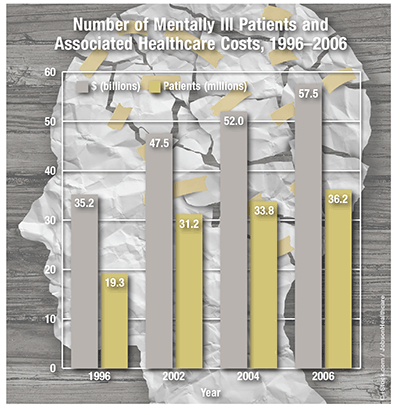US Pharm. 2015;40(11):20.
The World Health Organization reported that mental illnesses are the leading cause of disability-adjusted life-years worldwide, accounting for 37% of healthy years lost to noncommunicable diseases at a cost of $2.5 trillion. In 2013, 18.5% (43.8 million) of American adults suffered from mental illness, and 4.2% (10 million) were diagnosed with serious mental illness. According to the National Institute of Mental Health, 6% of adults had a serious mental illness, with a majority (60.8%) of patients’ related expenses attributed to loss of earnings, 31.5% attributed to healthcare expenses, and 7.7% attributed to payments for disability benefits.

Number of People With Mental Health Care (MHC) Expenses: In 2003, 6.2% ($100 billion) of the $1,614 billion spent on healthcare was for MHC. In 2006, more people paid expenses for the five most costly medical conditions than in 1996; mental disorders had the highest increase (+87.6%), followed by asthma and cancer at +20.6% each. In 2006, the number of Americans incurring MHC expenses grew at an average annual rate of 4% between 2002 and 2006, but the annual expenditure increased by 5.26% per year. Even though 15.5% ($8.9 billion) of the total direct expense of $57.5 billion was for MHC for children (4.6 million), the per capita direct expense was 21.3% higher ($1,931) for children than for the average American.
Costliness of Medical Conditions: Between 1996 and 2006, direct expenses increased for the five most costly medical conditions. The lowest increase was for heart conditions (+8.2%), and the greatest increase was for mental disorders (+63.4%). In 2006, direct expenses for MHC were the same as those for cancer ($57.5 billion), preceded only by those for trauma-related disorders ($68.1 billion) and heart conditions ($78 billion). When the average cost per person was computed for these five medical conditions, mental health disorders ranked fourth ($1,591), with heart conditions ranking second ($3,964) and cancer ranking first ($5,167).
Expense and Payment Sources: Payments for retail drugs (23%) and physicians and other professionals (22%) were the top two MHC expenses, followed by payments for multiservice mental health organizations (13%) and specialty hospitals (12%). Insurance administration, nursing homes and home health, and general hospital specialty units each consumed 7% of the total MHC expenditure. MHC offered in a residential setting (15%) was less costly than inpatient (24%) and outpatient care (31%). Of payments made for MHC, 58% came from publicly funded programs ($58 billion); Medicaid (26.1%) bore the largest share, followed by state and local programs (20.9%) and Medicare (7.5%).
To comment on this article, contact rdavidson@uspharmacist.com.





